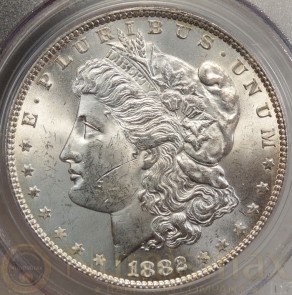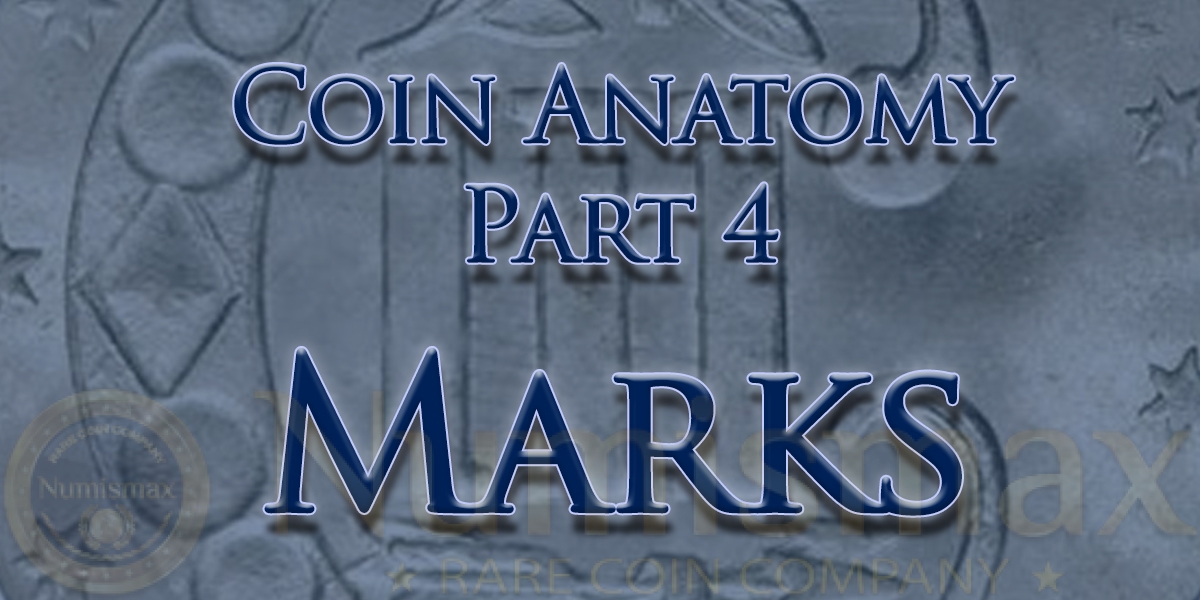Some are good. Some aren’t. Those tiny bumps, dents, dings, and scratches are all part of a coin’s natural life in circulation. Or are they? In this installment we will touch on the variety of Marks commonly found on coins.
Die cracks and die polishing. Some coins are destined to have marks even before they are struck. Made of hardened steel, dies can rust. As a result, cleaning is required. This is done with abrasive tools that leave marks on the dies, and therefore on the coins they strike. They are typically small parallel lines that can resemble cleaning, and some appear as small spikes hidden in the denticles. The subtle, yet tell-tale determiner is that the die polish marks will have the same surface texture and sheen as the rest of the coin. Dies get used for as long as possible, and this leads to wear on the die. Some even break in the process of striking coins. These cracks leave raised marks on the coins they strike. Small and irregular, these are easy to spot once you know what to look for.
 Bag Marks. As we discussed in the previous installment, a business struck coin comes off of the die, lands in a bin or barrel, then is carted off to be rolled or bagged. They are then loaded on to a truck or a train, and delivered to banks to be distributed as money. As far as the coin is concerned, this is a bumpy ride full of lots of scrapes and other impacts with its numismatic neighbors. All of this jostling leaves impressions on the coin called “bag marks.” Bag marks are normal, common, and are key elements in determining the grade of a “mint state” coin.
Bag Marks. As we discussed in the previous installment, a business struck coin comes off of the die, lands in a bin or barrel, then is carted off to be rolled or bagged. They are then loaded on to a truck or a train, and delivered to banks to be distributed as money. As far as the coin is concerned, this is a bumpy ride full of lots of scrapes and other impacts with its numismatic neighbors. All of this jostling leaves impressions on the coin called “bag marks.” Bag marks are normal, common, and are key elements in determining the grade of a “mint state” coin.
Wear. Once a coin has been in circulation, it gets rubbed between fingers, taken in and out of cash registers, carried around in pockets and purses, and who knows what else on it’s natural journey through the world as a coin. Luster is rubbed off of the high points first. Then the middle of the fields. The smaller details are smoothed out, and the luster is worn away from everywhere but the shadows of the larger devices. Eventually, all of the detail is worn away, and even the rims are smoothed into the fields. Even though this may take years, all coins in circulation face this same fate. It is all a perfectly natural part of the journey from Mint State to About Good or even lower. Coins exhibiting wear are considered “original,'” can be certified by a third party grader, and subsequently be priced according to the pricing guides. Bag Marks and wear are natural marks in the life of a coin, but what about all of those others?
 Some are accidental, some are nefarious, and some defy the imagination. There is no end to the types of “unnatural” marks found on coins. There are, however, some common types to look out for.
Some are accidental, some are nefarious, and some defy the imagination. There is no end to the types of “unnatural” marks found on coins. There are, however, some common types to look out for.
Cleaning. This is coin grading’s “snake in the grass.” It can be difficult to detect, and it can surely bite you in the wallet when your’e not looking. It can take on a number of forms, but if you see lots of tiny hairlines that are uniformly going in one direction or another, beware! A cleaned coin is not certifiable, and should sell for roughly two grades lower than it’s original counterpart.
Staple scratches. Some dealers and collectors over the years used cardboard and mylar coin holders to keep their coins safe. Others use 2×2 flips. Some decided that it was a good idea to use staples to keep the holder closed and further protect the coin. Not a terrible idea by itself, but there’s a problem. What happens when you want to take that coin out of that holder? Unfortunately, many people didn’t take the proper care required to take the coins out of those holders, and inadvertently allowed the coin to come into contact with the staple. Metal on metal contact always leaves a mark, and staples are no different. Some of these scratches can be quite small. Beware, and look for the raised metal at the edge of the scratch as the tell-tale indicator.
 Alteration. Residing in the realm of counterfeit coins, altered coins contain marks that are meant to deceive. When looking at a key date raw coin, be on the look out. Check the date and the mint mark closely. Are there any tooling marks that don’t seem right? If so, trust your instincts and walk away. A removed or added mint mark, or an altered date are some of the most common and deceptive counterfeits out there.
Alteration. Residing in the realm of counterfeit coins, altered coins contain marks that are meant to deceive. When looking at a key date raw coin, be on the look out. Check the date and the mint mark closely. Are there any tooling marks that don’t seem right? If so, trust your instincts and walk away. A removed or added mint mark, or an altered date are some of the most common and deceptive counterfeits out there.
The list goes on. Glue, ink, tape, paint, holes that have been bored then filled, even the classic of being placed on a train track, if you can imagine it, it has probably happened to a coin. Be ever vigilant on your numismatic search. Know the diagnostics of the coins that you are looking for, and you will always wisely navigate the seas of numismatic acquisition. Remember, knowledge is power! Thanks for reading this installment on Marks in our Coin Anatomy series.

